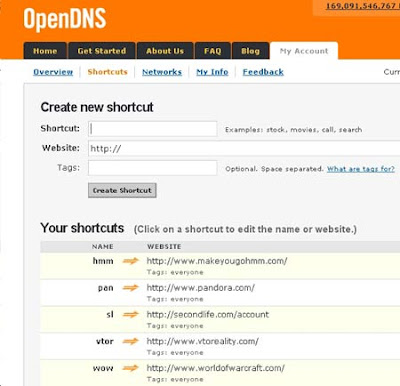
OpenDNS offers DNS resolution for consumers and businesses as an alternative to using their Internet service provider's DNS servers. By placing company servers in strategic locations and employing a large cache of the domain names, OpenDNS usually processes queries much more quickly, thereby increasing page retrieval speed. DNS query results are sometimes cached by the local operating system and/or applications, so this speed increase may not be noticeable with every request, but only with requests that are not stored in a local cache.
Other features include a phishing filter, domain blocking and typo correction (for example, typing wikipedia.og instead of wikipedia.org). By collecting a list of malicious sites, OpenDNS blocks access to these sites when a user tries to access them through their service. OpenDNS recently launched Phishtank, where users around the world can submit and review suspected phishing sites.
OpenDNS is not, as its name might seem to imply, open source software.
OpenDNS earns a portion of its revenue by resolving a domain name to an OpenDNS server when the name is not otherwise defined in DNS. This has the effect that if a user types a nonexistent name in a URL in a web browser, the user sees an OpenDNS search page. Advertisers pay OpenDNS to have advertisements for their sites on this page. While this behavior is similar to VeriSign's previous Site Finder or the redirects many ISP's are placing on their own DNS servers, OpenDNS states that it is not the same, as OpenDNS is purely an opt-in service (compared to Site Finder's effect on the entire Internet, as VeriSign is an authoritative registry operator) and that the advertising revenue pays for the customized DNS service. Note that web browsers are not the only users of DNS resolution service and for any other user, this way of resolving names is at best useless, and may be worse than replying that the name does not exist, as is normal.
According to OpenDNS, it may in the future provide additional services that run on top of its enhanced DNS service, and may charge money for some of them.
One example of such an added service was the company's April 22, 2007 launch of "shortcuts", letting users make custom DNS mappings, such as mapping "mail" to "mail.yahoo.com". This feature launch was covered by a large number of publications, including the New York Times, Wired, and PC World.
On May 13, 2007, OpenDNS launched a new domain blocking service which provides the ability to block/filter web sites visited based upon categories. This provides for corporate, educational and parental control over the type of sites that are deemed appropriate by the networks owner. On August 9, 2007 OpenDNS added the ability to override the filter through individually managed blacklists and whitelists. On February 20, 2008 in an effort to make their domain block list current with new website additions OpenDNS changed from a closed list of blocked domains to a community driven list whereby individual OpenDNS subscribers can suggest sites for blocking. If a sufficient number of other subscribers concur with the categorization of the site it is added to the appropriate category for blocking. The threshold of votes required to add a new site to the filter has not been disclosed. Over 50 categories now exist for categorizing websites providing for fine grained control over web browsing habits.
visit the official site:- http://www.opendns.com/
the details to setup openDNS is provided in the website.
tell2humanlinux@gmail.com







No comments:
Post a Comment